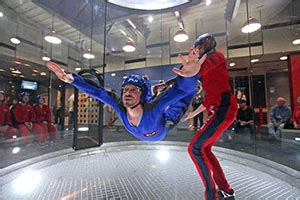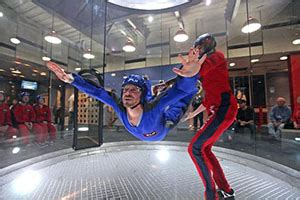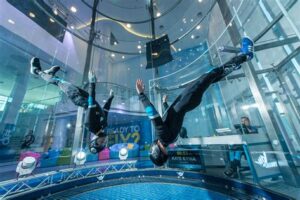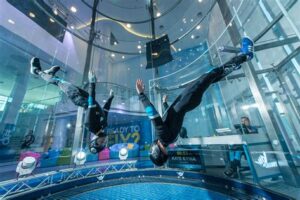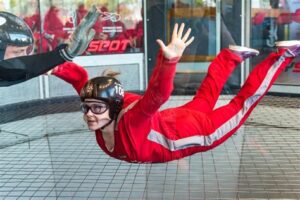Table of Contents
Discover the safety of indoor skydiving and how it provides an exhilarating experience without the risks of traditional skydiving. Explore the controlled environment, professional instructors, and state-of-the-art equipment that ensure a secure and enjoyable adventure. Unleash your inner thrill-seeker with this thrilling activity that guarantees an adrenaline rush in a safe and controlled setting.
Indoor skydiving has become an increasingly popular activity for thrill-seekers and adventure enthusiasts around the world. However, many potential participants may wonder just how safe this exhilarating experience truly is. Well, fear not, as we are here to shed light on the safety measures and precautions taken in the realm of indoor skydiving. So, buckle up and prepare to be reassured as we delve into the world of this gravity-defying sport!
Introduction
Indoor skydiving has become an increasingly popular activity for thrill-seekers seeking the adrenaline rush of freefalling without the need to jump from a plane. This exhilarating experience simulates the sensation of skydiving by using a vertical wind tunnel that propels air upwards, allowing participants to float on a cushion of air. While it may seem like a daring adventure, many wonder just how safe indoor skydiving really is. In this article, we will explore the safety measures and precautions put in place to ensure a secure and enjoyable experience for all participants.
The Technology Behind Indoor Skydiving
Before delving into the safety aspects, it is essential to understand the technology that makes indoor skydiving possible. Vertical wind tunnels are specifically designed to create a controlled airflow environment that mimics the sensation of freefalling. These tunnels consist of a powerful fan at the base, which pushes air through the flight chamber, creating a strong upward flow of air. This airflow allows participants to experience the sensation of floating in mid-air, similar to what they would feel during an actual skydive.
High Safety Standards
Indoor skydiving facilities adhere to strict safety standards to ensure the well-being of participants. These standards encompass various aspects, including equipment maintenance, instructor qualifications, and facility design. The tunnels are regularly inspected to guarantee their structural integrity and proper functioning. Additionally, all instructors undergo extensive training and certification processes to ensure they possess the necessary skills and knowledge to guide participants safely through each session.
Training and Instruction
Prior to entering the wind tunnel, participants receive comprehensive training on the proper body positions and hand signals used during the indoor skydiving experience. Instructors go through the fundamental techniques of maintaining stability in the airflow, such as body posture and limb positioning. This training helps participants understand how to maximize safety and enjoy a smooth and controlled flight experience.
Personal Protective Gear
Just like outdoor skydiving, indoor skydiving requires participants to wear specific safety gear. This typically includes a jumpsuit, helmet, goggles, and earplugs. The jumpsuit helps maintain aerodynamic stability during flight, while the helmet and goggles protect the head and eyes from any potential impact or debris. Earplugs are provided to protect against the noise generated by the powerful wind tunnel fans.
Instructor Supervision
Throughout the indoor skydiving experience, participants are constantly supervised by trained instructors. These instructors monitor each person’s flight, ensuring they maintain a stable and controlled position within the wind tunnel. They also provide real-time guidance and corrections to help participants improve their technique and maximize their enjoyment while prioritizing safety at all times.
Physical Limitations and Health Concerns
While indoor skydiving is generally considered safe, certain physical limitations and health concerns may restrict some individuals from participating. Those with heart conditions, back problems, or recent surgeries are advised to consult with their healthcare provider before attempting indoor skydiving. It is crucial to disclose any pre-existing medical conditions or concerns to the facility staff to ensure the activity is suitable for each individual.
Age and Weight Restrictions
Indoor skydiving facilities typically have age and weight restrictions in place as additional safety measures. The minimum age requirement varies between establishments, but it is usually around six years old. Similarly, there is usually a maximum weight limit due to equipment constraints. These restrictions aim to provide a safe and comfortable experience for all participants while considering the limitations of the technology and equipment used.
Emergency Preparedness
Indoor skydiving facilities prioritize emergency preparedness to handle any unforeseen situations effectively. Staff members are trained in first aid and CPR, ensuring they can provide immediate assistance if needed. Additionally, the wind tunnels are equipped with emergency shut-off systems that can be activated quickly in case of any malfunction or potential danger.
Customer Reviews and Feedback
Finally, it is always beneficial to research customer reviews and feedback before visiting an indoor skydiving facility. Hearing about others’ experiences can provide valuable insights into the overall safety and quality of the establishment. Look for positive reviews highlighting the professionalism of the staff, adherence to safety protocols, and overall customer satisfaction. This information can help make an informed decision when choosing a facility for your indoor skydiving adventure.
Conclusion
Indoor skydiving offers an exhilarating experience in a controlled environment, ensuring high levels of safety for all participants. With strict safety standards, comprehensive training, and experienced instructors, the risk associated with this activity is minimal. As with any adventure sport, it is crucial to adhere to the guidelines provided by the facility and disclose any relevant health concerns. By doing so, you can enjoy a thrilling and safe indoor skydiving experience that will leave you with memories to cherish for a lifetime.
How Safe Is Indoor Skydiving?
Welcome to our guide on indoor skydiving safety! In this article, we will provide you with important information and guidelines to ensure your safety while enjoying this exhilarating activity. Please read and follow these instructions carefully before engaging in indoor skydiving.
1. Understand the Safety Precautions:
Before participating in indoor skydiving, it is crucial to familiarize yourself with all the safety precautions put in place by the facility. Review safety guidelines, watch any instructional videos provided, and ask questions to the staff if anything is unclear.
2. Proper Use of Protective Gear:
Always ensure you are wearing the appropriate protective gear, including a jumpsuit, helmet, goggles, and earplugs. Make sure all gear is properly fitted and secured to minimize the risk of injury during your indoor skydiving experience.
3. Follow Instructor’s Directions:
Listen attentively to the instructions provided by your instructor. Follow their guidance on body positioning, hand signals, and how to properly exit and enter the wind tunnel. Remember that the instructor’s main responsibility is ensuring your safety, so it’s important to trust and follow their advice.
4. Be Aware of Physical Limitations:
Before taking part in indoor skydiving, be aware of any physical limitations you may have that could impact your safety. It’s essential to communicate any medical conditions, injuries, or physical restrictions to the staff beforehand so they can provide appropriate guidance and ensure your safety during the activity.
5. Monitor Wind Tunnel Conditions:
Pay attention to the wind tunnel conditions and be aware of any sudden changes or malfunctions. If you notice anything unusual during your session, promptly notify the instructor or staff to address the situation and avoid potential risks.
6. Stay Alert and Focused:
Maintain focus and concentration while participating in indoor skydiving. Avoid distractions, such as taking pictures or waving to spectators, as they can detract from your safety. It’s important to stay alert and attentive to your surroundings, the instructor’s guidance, and any potential risks that may arise.
7. Respect Personal Limits:
Know your personal limits and do not push yourself beyond what you feel comfortable with. Indoor skydiving is an adventurous activity, but it’s crucial to gauge your own physical and emotional readiness. If you feel overwhelmed or uncomfortable at any time during the experience, inform the instructor and seek assistance if needed.
8. Follow Emergency Procedures:
Familiarize yourself with the facility’s emergency procedures and be prepared to follow them if necessary. Stay calm and listen to instructions in case of a power outage, malfunction, or any other unforeseen circumstances. Being aware of emergency protocols will help ensure your safety and the safety of others in such events.
Conclusion:
Indoor skydiving can be a thrilling experience, but safety should always be a top priority. By understanding the safety precautions, following the guidance of the instructor, and staying alert to potential risks, you can enjoy this exhilarating adventure with peace of mind. Remember, never hesitate to ask questions or seek assistance when needed. Have a fantastic and safe indoor skydiving experience!
Indoor skydiving is a thrilling and exhilarating activity that has gained popularity in recent years. It provides the opportunity to experience the sensation of skydiving in a controlled and safe environment. However, it is important to understand the safety measures and follow the instructions provided to ensure a secure and enjoyable experience.
Here are some key points to consider when assessing the safety of indoor skydiving:
- Qualified instructors: Indoor skydiving facilities should have trained and certified instructors who are knowledgeable about the activity. These professionals are responsible for guiding participants and ensuring their safety throughout the experience.
- Proper equipment: The facility should provide participants with well-maintained gear, including jumpsuits, helmets, and goggles. It is essential to wear the equipment correctly and securely to minimize any potential risks.
- Clear instructions: Before entering the wind tunnel, participants should receive thorough instructions on body positioning, hand signals, and safety procedures. It is crucial to pay attention and understand these instructions to avoid any accidents or injuries.
- Physical fitness: While indoor skydiving is generally suitable for people of various fitness levels, it is important to be in good health and inform the instructors of any pre-existing medical conditions. This information will help them tailor the experience and make necessary adjustments to ensure safety.
- Constant supervision: Instructors closely monitor participants during their flights, offering guidance and assistance as needed. Their presence ensures a safe environment and immediate response in case of any emergencies.
- Maintaining wind tunnel conditions: The facility should regularly inspect and maintain the wind tunnel to ensure it operates smoothly and without any technical issues. This includes monitoring air quality, airflow, and temperature to provide a safe and comfortable experience for participants.
- Participant responsibility: Individuals should follow all safety guidelines, listen to instructions, and refrain from engaging in any risky behavior. It is crucial to respect the rules and regulations set by the facility to ensure personal safety and the safety of others.
By adhering to these safety measures and guidelines, indoor skydiving can be a remarkably safe activity. However, it is essential to choose a reputable facility that prioritizes safety and provides proper training to ensure a secure and enjoyable experience for all participants.
Thank you for visiting our blog and taking the time to read our article on indoor skydiving safety. We hope that we have provided you with valuable information and insights into this thrilling activity. As you may know, indoor skydiving has gained popularity in recent years as a safe alternative to traditional outdoor skydiving. In this closing message, we would like to summarize our findings and address any remaining concerns you may have.
First and foremost, it is important to note that indoor skydiving is considered to be a safe activity when proper precautions and guidelines are followed. The facilities that offer indoor skydiving experiences are equipped with state-of-the-art technology and trained instructors who prioritize safety above all else. These facilities undergo regular inspections to ensure that all equipment is in good working condition and that safety protocols are being adhered to.
During an indoor skydiving session, participants are provided with a specialized jumpsuit, helmet, and goggles to ensure their safety. Additionally, trained instructors are present at all times to guide and assist participants. Before each session, participants are given detailed instructions on body positioning, hand signals, and safety procedures. These measures are put in place to minimize any potential risks and ensure a safe and enjoyable experience for everyone.
While indoor skydiving is generally safe, it is important for individuals to assess their own physical health before participating. People with certain medical conditions such as heart problems, back or neck injuries, or pregnancy may be advised against indoor skydiving. It is crucial to disclose any relevant medical information to the facility staff before booking a session to ensure your own safety.
In conclusion, indoor skydiving is a thrilling and safe activity that can be enjoyed by people of all ages and fitness levels. With the right safety measures in place and the guidance of trained instructors, you can experience the exhilaration of skydiving in a controlled and secure environment. We hope that this article has helped answer any questions you may have had about the safety of indoor skydiving, and we encourage you to explore this unique and exciting activity for yourself!
Thank you once again for visiting our blog, and we look forward to providing you with more informative content in the future. If you have any further questions or would like to share your own experiences with indoor skydiving, please feel free to leave a comment below. Safe travels!
.
How Safe Is Indoor Skydiving?
People also ask:
- Is indoor skydiving safe for beginners?
- What are the risks of indoor skydiving?
- Can you get hurt from indoor skydiving?
- Are there age restrictions for indoor skydiving?
- Is indoor skydiving safer than outdoor skydiving?
Answer:
- Is indoor skydiving safe for beginners?
- What are the risks of indoor skydiving?
- Can you get hurt from indoor skydiving?
- Are there age restrictions for indoor skydiving?
- Is indoor skydiving safer than outdoor skydiving?
Yes, indoor skydiving is generally safe for beginners. It is a controlled and supervised activity that provides a simulated skydiving experience in a wind tunnel. Professional instructors are present to guide beginners and ensure their safety throughout the session.
The risks associated with indoor skydiving are minimal compared to traditional outdoor skydiving. While injuries are rare, there is a slight possibility of minor bruises, muscle strains, or motion sickness. However, following the instructions provided by the instructors can significantly mitigate these risks.
The chances of getting seriously hurt during indoor skydiving are extremely low. The wind tunnel environment is designed to provide a safe and controlled experience. However, it is essential to listen to the instructions given by the instructors, follow safety protocols, and wear appropriate gear to minimize any potential risks.
Age restrictions may vary depending on the facility and country regulations. However, many indoor skydiving centers allow participants as young as three years old. Certain restrictions may apply for individuals with pre-existing medical conditions or physical limitations. It is best to check with the specific facility beforehand.
Indoor skydiving is generally considered safer than outdoor skydiving due to its controlled environment. Outdoor skydiving involves jumping out of an aircraft at high altitudes, which presents additional risks. However, both activities have their own safety measures in place, and it is crucial to follow instructions and guidelines provided by professionals for a safe experience.

